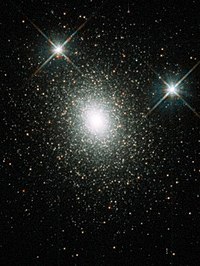
Photo from wikipedia
Under certain conditions, stars close to intermediate-mass black holes (IMBHs) can form close binary systems with these objects, in which the Roche lobe can be filled by the star and… Click to show full abstract
Under certain conditions, stars close to intermediate-mass black holes (IMBHs) can form close binary systems with these objects, in which the Roche lobe can be filled by the star and intense accretion of the star’s matter onto the IMBH is possible. Recently, accreting IMBHs have been associated with hyperluminous X-ray sources (HLXs), whose X-ray luminosities can exceed 1041 erg/s. In this paper, the evolution of star—IMBH binary systems is investigated assuming that the IMBH mainly accretes the matter of its companion star, and that the presence of gas in the vicinity of the IMBH does not appreciably affect changes in the orbit of the star. The computations take into account all processes determining the evolution of ordinary binary systems, as well as the irradiation of a star by hard radiation during the accretion of its matter onto the IMBH. The absorption of external radiation in the stellar envelope was calculated applying the same formalism that is used to calculate the opacity of the stellar matter. The computations also assumed that, if the characteristic time for the mass transfer is less than the thermal time scale of the star, there is no exchange betwween the orbital angular momentum of the system and the angular momentum of the matter flowing onto the IMBH.
Journal Title: Astronomy Reports
Year Published: 2019
Link to full text (if available)
Share on Social Media: Sign Up to like & get
recommendations!